As you may have noticed by now, Soviet Bloc computers are not in any way a speciality of mine. Still, there was one model that I longed for since some time because there was also some sort of Forth version of it: the Hobbit. So, recently I was able to finally buy one out of Ebay.
The Hobbit was in one way the typical Soviet computer. It is a Sinclair Spectrum clone, made mainly for the Soviet market. In another way, the unusual thing about it that it was (briefly) sold also in the West as an upmarket version of the Spectrum in the 1990s.
So I thought, writing a short blog entry was easy: there are comparatively many (for a Soviet computer) English information pages on the Hobbit on the Internet. There is no picture of the PCB, so, that’s what I could contribute.
But then parts started not to fit together. My machine (clearly labelled Hobbit) did not really fit most descriptions that I found. Soon, it became clear to me that the Hobbit is really a small family of different machines, but nobody in the English-speaking world seems to be aware of that. So I conjectured and made up wild theses, but found in the end a Russian page which cleared up things. So, what’s what?
There are three versions of the Hobbit:
The (original) Hobbit
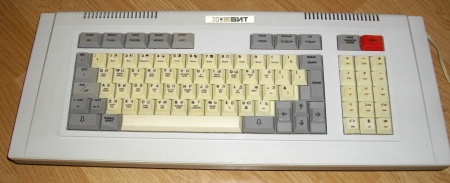
It is the earliest model. It is a “Super Spectrum” with its full keyboard, 3.5MHz Z80, 64 kB RAM, 64 kB ROM, (serial) network capabilities, 3 joystick ports, up to 4 5.25″ floppy disk drives connectable, Centronics port, CP/M clone OS, and so on. This is also the version for which there were many different EEPROM images available, offering Basic, Logo, Forth, and so on. (This is also the version I wanted to have :-).
The Hobbit console (Игровой автомат or ИА Хоббит (IA Hobbit))
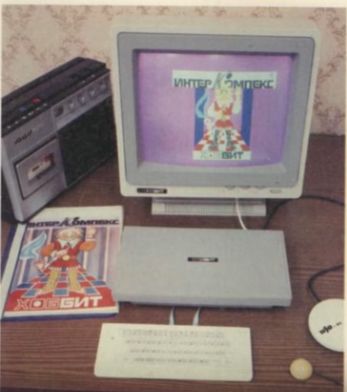
The Hobbit console is to the Hobbit what the C64GS was to the C64: basically the same computer but without a keyboard and lacking most of the peripherals. The Hobbit console had a tape connector (but no module slot), and two joystick ports. It was produced in 1989-1990 and was sold at a price of ~1000 rubles in 1990 in the Soviet Union (but apparently not in the West). An external keyboard (sold separately) could be connected. As there was normally no keyboard, but the computer is still basically a Spectrum, the ROM was modified so it issued a LOAD “” automatically after startup.
The “Programmable Console Hobbit” ((“Программируемый Игровой Автомат Хоббит”, or ПИА Хоббит or PIA Hobbit)

This is the version that I have. It looks a little bit like the pale, less posh version of the Spectrum+. It is the Hobbit console plus an integrated keyboard. Like the console, it does not have any floppy or network interfaces, only a tape interface. It has only two joystick interfaces. It has 64 kB of (Sowjet production) RAM, but in the ROM socket there is only a 16 kB (Taiwan) EEPROM chip, possibly a replacement. It is unclear whether a 64 kB EEPROM can be used. It has an original Zilog Z80 CPU soldered in. The keyboard has English keys, but on the left top side there are three buttons with Kyrillic text above it. These read “Network”, “Video” and “Reset”. Now, you might want to ask me: Why a “Network” button? I have no idea. Interestingly, this button is as yellow as the normal keyboard while the other to buttons are paler in color. Maybe they had paper labels on them because the user did not speak Russian and the “Network” button was never used? BTW, the “Video” button is a “radio button” that stays down when pressed, whereas the other two buttons are reset-type buttons. This model dates to 1992.

That’s the underside. Apparently, one can calibrate the colors here with a screwdriver?
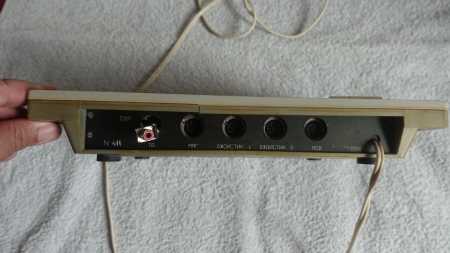
That’s the back. From left to right: TV, Tape, Joystick 1, Joystick 2, power cord. Yes, one of the last owners has fitted a TV output connector to it, danngling quite loosely out of the case. On the top left corner it even says “ПИА” (PIA).
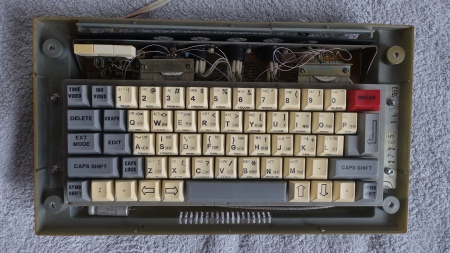
That’s the computer with the top cover removed (use the four lowest screws on the back). Note that the keyboard has a “1992” stamp on the metal on the right.
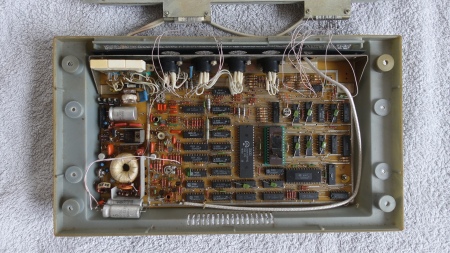
Voila, finally a PCB picture. As you can see, the keyboard is connected to the main PCB by a series of single, very thin wires. All in all the Hobbit seems to require a lot of hand soldering. There seems not be a possibility to fit a network interface in the back.
Numberwise, it is not clear how many Hobbits were made. The 1990 article, Rage Hard colports a number of 15000 Hobbits the manufacturer claims to have sold until then. Nowadays, on Ebay a Hobbit is a quite rare thing.
Knowing the things above I can even correct two incorrect pages on the Hobbit:
- Stefan Walgenbach of http://www.homecomputer.de writes in (http://www.homecomputer.de/pages/f_easteurope.html): “The early version of the Hobbit is a very limited “edition” of Hobbit. It was stopped being manufactured around early 1990, when InterCompex totally switched to the later version with the numeric keypad.” As we saw, this is not correct, the smaller Hobbit is the later one. Interestingly, his photo (http://zxspectrum48.i-demo.pl/clones_pliki/Hobbit.jpg) of the PIA is a little bit different to mine.
- http://www.old-computers.com has a wrong photo on http://www.old-computers.com/museum/computer.asp?st=1&c=955 . This machine is not a Hobbit, it is a (similar looking) Forum BK-09 Turbo.
And I still need to find an original Hobbit for myself 😉
References
- https://en.wikipedia.org/wiki/Hobbit_(computer)
- http://speccy.info/%D0%A5%D0%BE%D0%B1%D0%B1%D0%B8%D1%82
- http://www.tarunz.org/~vassilii/Hobbit/
- http://zxdimsla.chat.ru/ZXHOBBIT/title.htm
- https://web.archive.org/web/20040819190407/
- http://www.ysrnry.co.uk/articles/ragehard0990.htm
- https://web.archive.org/web/20040819192801/
- http://www.ysrnry.co.uk/articles/ragehard0191.htm
- https://web.archive.org/web/20040705021710/
- http://www.sincuser.co.uk/126/hobbit.htm
- https://www.youtube.com/watch?v=LrUNiRXZu30
I want to thank Anastasiia Iurshina for translating the text on the case of my PIA Hobbit!
September 27, 2019 at 11:39 |
I recently managed to obtain a small Hobbit as well, interestingly mine has jacks for connecting the keyboard ribbon cables (instead of going directly to the soldering points), but on the keyboard they’re cut short and lenghtened with small wires as well. The machine is quite interesting, timing seems to be quite close to the original Sinclair machines, but some part of the RAM seems to be decoded to the border, resulting in flickering in different colors during demoparts. Also the “Paper”-area of the screen is slightly shifted to the bottom and right.
The keyboard itself seems to be generic (if you can speak of it) I’ve also seen it on Delta-S clones and as external keyboards for ZS Scorpion machines.
October 6, 2019 at 01:26 |
Also interesting they seem to have used a KR556RT2 (82S100) PLD to consolidate some logic.
If you ever manage to find some schematics let me know …
February 7, 2020 at 13:14 |
“Сеть” means not “Network” but “Mains” in russian. So this is the power switch. “Видео” button inverts the video signal. Original device had ribbon keyboard cables and sockets. This devices were built industrially – not a “hand made”. I have one since 90x. It had 64K RAM + 16K ROM, and I had no idea how to use additional 16K RAM bank (original Spectum had 48K + 16K = 64K memory).